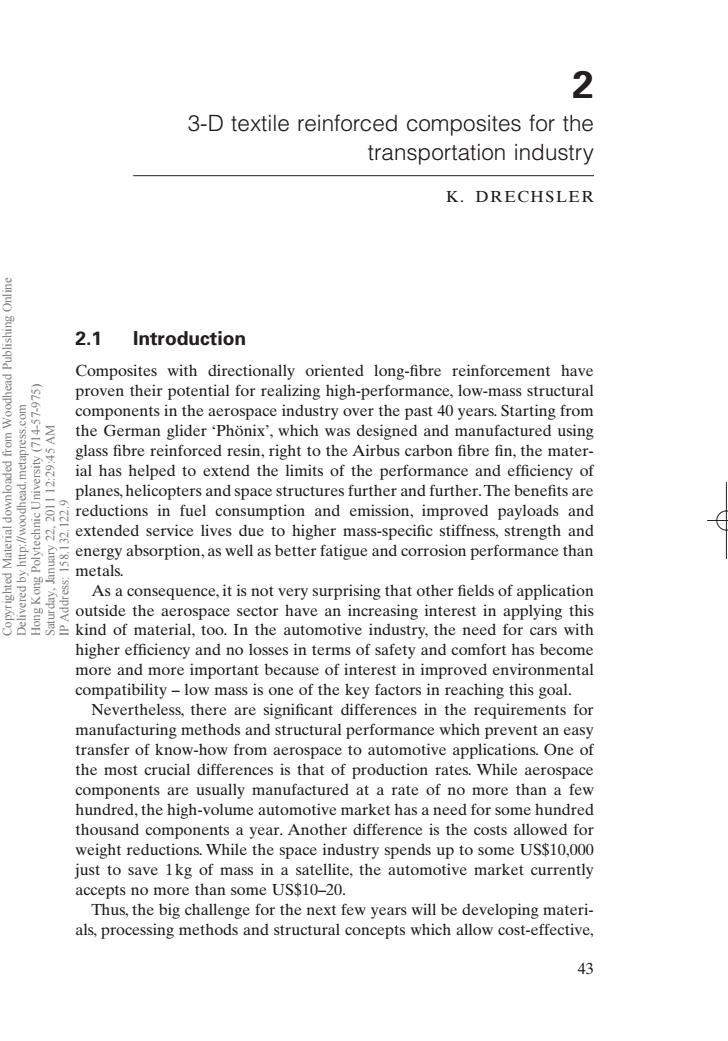正在加载图片...

2 3-D textile reinforced composites for the transportation industry K.DRECHSLER 2.1 Introduction Composites with directionally oriented long-fibre reinforcement have proven their potential for realizing high-performance,low-mass structural components in the aerospace industry over the past 40 years.Starting from the German glider 'Phonix',which was designed and manufactured using glass fibre reinforced resin,right to the Airbus carbon fibre fin,the mater- ial has helped to extend the limits of the performance and efficiency of planes,helicopters and space structures further and further.The benefits are reductions in fuel consumption and emission,improved payloads and extended service lives due to higher mass-specific stiffness,strength and energy absorption,as well as better fatigue and corrosion performance than metals. n As a consequence,it is not very surprising that other fields of application outside the aerospace sector have an increasing interest in applying this kind of material,too.In the automotive industry,the need for cars with higher efficiency and no losses in terms of safety and comfort has become more and more important because of interest in improved environmental compatibility-low mass is one of the key factors in reaching this goal. Nevertheless,there are significant differences in the requirements for manufacturing methods and structural performance which prevent an easy transfer of know-how from aerospace to automotive applications.One of the most crucial differences is that of production rates.While aerospace components are usually manufactured at a rate of no more than a few hundred,the high-volume automotive market has a need for some hundred thousand components a year.Another difference is the costs allowed for weight reductions.While the space industry spends up to some US$10,000 just to save 1kg of mass in a satellite,the automotive market currently accepts no more than some US$10-20. Thus,the big challenge for the next few years will be developing materi- als,processing methods and structural concepts which allow cost-effective, 432.1 Introduction Composites with directionally oriented long-fibre reinforcement have proven their potential for realizing high-performance, low-mass structural components in the aerospace industry over the past 40 years. Starting from the German glider ‘Phönix’, which was designed and manufactured using glass fibre reinforced resin, right to the Airbus carbon fibre fin, the material has helped to extend the limits of the performance and efficiency of planes, helicopters and space structures further and further.The benefits are reductions in fuel consumption and emission, improved payloads and extended service lives due to higher mass-specific stiffness, strength and energy absorption, as well as better fatigue and corrosion performance than metals. As a consequence, it is not very surprising that other fields of application outside the aerospace sector have an increasing interest in applying this kind of material, too. In the automotive industry, the need for cars with higher efficiency and no losses in terms of safety and comfort has become more and more important because of interest in improved environmental compatibility – low mass is one of the key factors in reaching this goal. Nevertheless, there are significant differences in the requirements for manufacturing methods and structural performance which prevent an easy transfer of know-how from aerospace to automotive applications. One of the most crucial differences is that of production rates. While aerospace components are usually manufactured at a rate of no more than a few hundred, the high-volume automotive market has a need for some hundred thousand components a year. Another difference is the costs allowed for weight reductions. While the space industry spends up to some US$10,000 just to save 1kg of mass in a satellite, the automotive market currently accepts no more than some US$10–20. Thus, the big challenge for the next few years will be developing materials, processing methods and structural concepts which allow cost-effective, 2 3-D textile reinforced composites for the transportation industry K. DRECHSLER 43 RIC2 7/10/99 7:24 PM Page 43 Copyrighted Material downloaded from Woodhead Publishing Online Delivered by http://woodhead.metapress.com Hong Kong Polytechnic University (714-57-975) Saturday, January 22, 2011 12:29:45 AM IP Address: 158.132.122.9